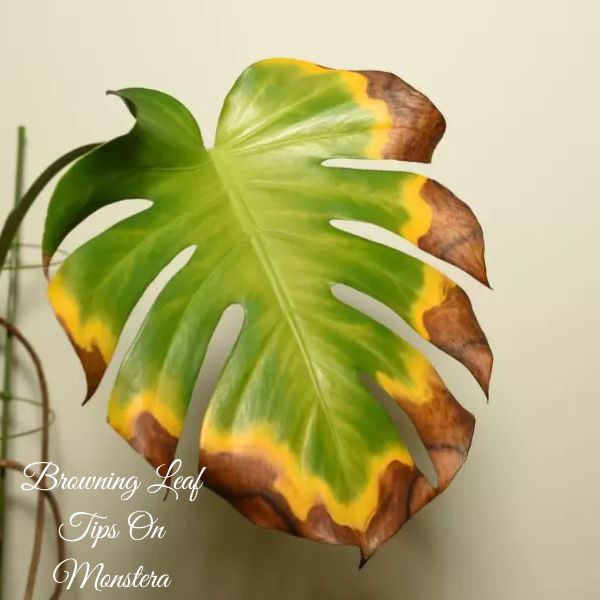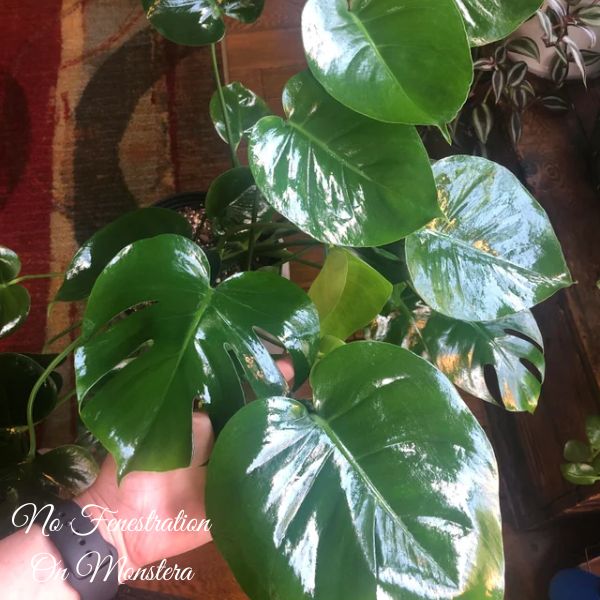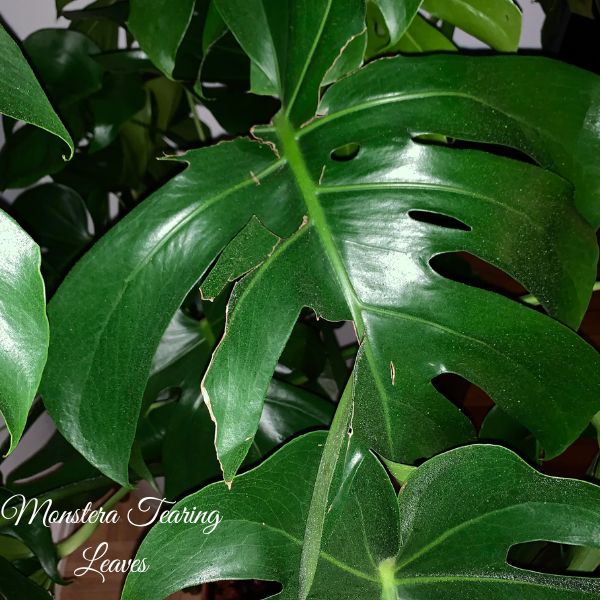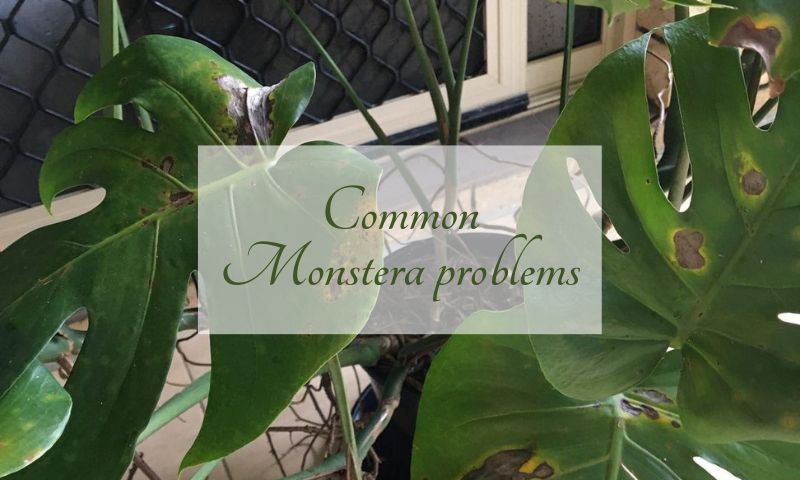Monsteras are having a major moment right now as the trendiest houseplant. With their vibrant green, hole-filled leaves, it’s easy to see why these tropical beauties are so popular. However, keeping a Monstera healthy and thriving can be tricky at times. Even the most diligent plant parents run into issues with these Instagram-worthy plants. If your Monstera isn’t looking its best, don’t fret! In this post, I’ll walk you through the 15 most common Monstera problems, along with clear pictures and easy solutions.
From yellowing leaves to pest infestations, I’ll help you get to the root of what’s troubling your plant so you can get your Monstera back to its gorgeous glory. Arm yourself with knowledge on these common Monstera problems so you can catch issues early and take the right steps to nurture your plant back to health. With the right care, your Monstera can grow into a showstopping statement plant that brings life and beauty to your home.
15 Common Monstera Problems Overview
| Problem | Cause | Solution |
|---|---|---|
| Yellow leaves | Too much sun, overwatering, underwatering | Adjust light exposure, check soil moisture before watering |
| Browning leaf tips | Inconsistent watering, excess light/heat, overfertilizing | Water when top inches of soil become dry, move plant back from windows, flush soil monthly |
| Wilting | Irregular watering, temperature changes, drafts | Check soil moisture, keep temps 65-75°F, move plant away from drafts |
| Yellow spots | Uneven soil moisture | Allow top inches of soil to dry before watering thoroughly |
| No fenestrations | Insufficient light, root-bound | Move to brighter location, repot into larger container |
| Lack of new leaves | Inadequate light, moisture, nutrition | Supplement light to 12-14 hours daily, water when dry, fertilize every 2-3 weeks |
| Curling leaves | Irregular watering, light, temps/humidity | Water when top inches are dry, provide bright indirect light, increase humidity |
| Root rot | Overwatering | Allow soil to dry out more between waterings |
| Leaves turning black | Too much sun, irregular watering, pests | Filter light, check soil moisture, treat for pests |
| Leaves browning | Excessive light, irregular watering, low humidity | Filter light, check soil moisture, increase humidity |
| Bugs | Spider mites, mealybugs, etc. | Treat with insecticidal soap, neem oil |
| Stunted growth | Insufficient light, water; pests | Adjust light, water, treat pests |
| Leggy growth | Inadequate light, water, etc. | Supplement light to 12+ hours daily, check soil moisture |
| Tearing leaves | Excessive light, low humidity, pests | Filter light, increase humidity, treat pests |
| Unbalanced growth | Uneven light or watering | Rotate pot for even light, water entire soil area |
Yellow Leaves

Seeing those vibrant green leaves slowly turn yellow can set off alarm bells for any Monstera parent. But don’t fret – yellowing leaves are one of the most common issues with Monsteras, and they can usually be corrected with a few adjustments to your care routine.
Monsteras prefer bright, indirect sunlight – too much direct sun will scorch their leaves, causing yellowing and browning. If your plant is placed in a south or west facing window, move it back from the window a few feet to ensure it’s not receiving too many harsh afternoon rays.
You’ll also want to pay close attention to your watering habits. Both overwatering and underwatering can cause leaves to yellow and drop. Check the soil moisture before watering – the top few inches should be dry, and soil deeper down should still feel lightly moist. I recommend watering only when the top couple of inches become totally dry.
Finally, monitor your fertilizer regimen. Yellowing Monstera Leaves along the veins and new growth often indicates a nutritional deficiency. Use a balanced liquid fertilizer diluted to half strength every two weeks in the growing season to provide Monsteras with a steady diet. Slow release pellets worked into the soil in spring can also feed them gradually over time.
Keeping these key aspects optimized will help ensure your Monstera stays healthy with vibrant, deep green leaves. Catch discoloration right away and diagnose the underlying cause to get your plant flourishing again!
Browning Leaf Tips

Nothing ruins the flawless look of a Monstera leaf faster than unsightly brown tips. While it might set off alarm bells, brown leaf tips are typically an easy fix – often caused by inconsistent watering.
Monsteras are tropical plants that thrive in evenly moist (but not soggy) soil. Allow the top two inches of soil to dry out between waterings, then soak the soil completely. Droughts between waterings can leave leaf tips crispy and brown. Conversely, overwatering can lead to root rot and leaf browning as well. Carefully monitor soil moisture and water only when needed to prevent issues.
Excessive heat and light can also scorch leaf tips. Try moving your Monstera a few feet back from hot, direct afternoon sun streaming through south or west windows. Maintain indoor temperatures between 65-80°F – installing fans to circulate air can help keep monsteras comfy in warmer rooms.
Finally, monitor your fertilizer regimen as well. Excess salts from overzealous fertilizing accumulate in leaf tips, leading to burn. Flush soil monthly by watering heavily to prevent buildup and crisping. Aim for a balanced liquid fertilizer diluted to half strength every 2-3 weeks during growth periods.
Catching browning tips early allows you to diagnose the underlying issue, whether it be inconsistent watering, excess light or heat, or overfeeding. With a few adjustments to your Monstera care regimen, you’ll have healthy plants with flawless leaves in no time!
You may also like: How often to Water Monstera Plant for Optimal Growth
Wilting

Wilting is common among Monstera plants and it can be due to loads of stuff like lack of water, temperature changes, soil that’s too soggy or too dry, not enough nutrients, root rot, and pests. But don’t worry, there’s stuff you can do to sort it out.
- Drought stress: Check the soil before watering your plant. If it feels dry, then it’s time to give your plant some water, but be careful not to drown it because this can cause root rot and other monstera issues.
- Temperature fluctuations: Make sure your plant’s in a spot that’s not too hot or too cold, ideally somewhere between 65-75 degrees Fahrenheit (18-24 degrees Celsius).
- Drafts: Drafts might mess up wilting your monstera plants because they can dry out the leaves and roots. If your monstera plant is wilting, check to make sure it is not in a drafty location. If it is, shift it to a place where it will be protected from those drafts.
- Incorrect soil moisture: When you water your plant check the soil for drainage. If the soil’s too soggy or too dry, put your plant in soil that drains better.
- Nutrient deficiencies: Feed your plant with balanced liquid plant food once a month during the growing season so it’s getting everything it needs.
- Root rot and pest problems: If you think root rot might be the problem, look for decay signs near the roots and put your plant in fresh soil if you need to. To get rid of bugs, give the leaves a gentle wash every few weeks with a mild soapy solution.
Yellow Spots

Nothing mars the beauty of a Monstera’s iconic leaves faster than splotches of yellow spreading across their surface. These yellow spots typically indicate inconsistent soil moisture – whether from overwatering or underwatering. Addressing irrigation issues quickly prevents more serious problems down the road.
Yellow spots accompanied by soft, drooping leaves generally signal overwatering. Check that your Monstera has a well-draining potting mix, and allow the top few inches of soil to dry out before watering again. Cut back to water only when the top couple of inches become totally dry.
Conversely, underwatering causes similar yellowing when roots can’t take up enough moisture to support leaf transpiration. Check soil moisture deeper down – if bone dry, give your Monstera a deep soak until water drains freely from the bottom. Going forward, watch for the soil to become mostly dry before rewatering.
You can further support healthy transpiration by misting those gorgeous leaves every few days and running a humidifier nearby. Shoot for 40-50% humidity if possible. Finally, prevent excess sun exposure, which can scorch leaves.
Catching yellow spots early allows you to diagnose inconsistent irrigation and improve your Monstera care. Dial in a regimented watering routine to keep moisture steady, and your Monstera will reward you with unblemished, vibrant green leaves bringing vitality to any space.
No Fenestration

One of the most prized qualities of a mature Monstera is the development of dramatic fenestrations – the iconic splits and holes that grace their leaves. However, if your Monstera leaves remain stubbornly whole, it likely indicates your plant isn’t receiving enough light. This lack of light prevents proper leaf development known as “no fenestration.”
Monsteras thrive in bright, indirect light. If new growth emerges smaller and underdeveloped without any fenestrations, try moving your plant to a spot with more ambient brightness. West or East facing windows are ideal, providing gentle morning or afternoon sun. Just make sure to keep it back from the glass to prevent scorching!
Lack of fenestrations also indicates your plant may be root-bound. Check below the soil line – if you see lots of wayward roots circling the edges and bottom of the pot, it’s time to size up. Repotting into a container 2-4 inches wider gives roots more room to spread out and fuel exuberant, fenestrated new growth.
Finally, prune back any leggy stems or leaves growing small and yellow to direct energy towards new, vibrant foliage. Optimizing light exposure, space for root development, and strategic pruning gives your Monstera the growing conditions it needs to produce its signature stunning, fenestrated leaves that will be the envy of all your plant-loving friends!
Related: When do Monstera leaves split? How to encourage it splitting
Lack of New Leaves

Seeing mature leaves but no new emerging growth is a common problem that plagues Monstera parents. Lack of new foliage indicates your plant isn’t getting one of the key elements it needs to support vigorous growth.
Start by assessing light conditions. Monsteras need bright, indirect sun to fuel photosynthesis and new leaf production. Supplement with grow lights if ambient light is low, aiming for 12-14 hours daily. Inadequate moisture also causes slowed growth. Check soil regularly, watering when the top few inches become dry.
Next, examine your fertilizer regimen. Monsteras are heavy feeders and rely on essential nutrients like nitrogen to generate new foliage. Use a balanced houseplant fertilizer diluted to half strength every 2-3 weeks in the growing season.
Finally, rule out root issues. Gently remove from its pot and check for compacted, circling roots or soggy soil signaling poor drainage. Repotting annually in fresh soil stimulates root health to better nourish bursting new leaf growth.
Pinpointing the underlying cause – whether not enough light, irregular watering, poor nutrition, or restricted roots – allows proper adjustments in your care routine. With optimal conditions, your Monstera will readily churn out glossy new foliage!
Leaves Curling

Seeing those iconic split Monstera leaves curling unhappily signals distress in your plant. Curled foliage is typically caused by inconsistent moisture, lighting, humidity or temperatures. Getting to the root of the problem and correcting care will perk leaves right up!
Leaf curl often starts with irregular watering, as both overwatering and underwatering elicits this response. Check soil moisture before watering, allowing the top few inches to become dry before giving your Monstera a deep soak. Ensure proper drainage with a pot that has holes and prevent waterlogged soil.
Inadequate light also causes leathery Monstera leaves to curl inward or downward as plants stretch desperately for the sun. Supplement ambient light with grow bulbs, providing 12-14 hours of daily brightness. While at it, make sure your plant isn’t enduring too much harsh direct light either, which can scorch delicate leaves.
Leaf curl may indicate environmental distress too, as Monsteras thrive in daytime temps of 65-80°F and 40-50% humidity. Installing humidifiers or moving struggling plants into bathrooms can provide a dose of tropical ambience. Prevent chilly drafts which zap moisture.
Catch curling early and optimize moisture, light and ambient conditions to restore flat, happy Monstera foliage. Doing so keeps plants growing robustly and looking their best for years to come!
Root Rot

Seeing your once-vibrant Monstera foliage start to yellow and droop can set off alarm bells – and likely indicates that root rot has set in. This common issue arises from overwatering, which leaves soil sodden and deprives roots of oxygen. Getting a handle on watering habits is key to restoring health.
The first line of defense against monstera root rot is letting soil dry out adequately between waterings. Check moisture a few inches down before adding any additional water. The timing can vary based on climate, light exposure and other factors – but a good rule of thumb is to wait until the top 50% of soil becomes dry.
Well-draining soil is also paramount. Use a commercial Monstera blend or mix in perlite, bark chips or coconut coir to maintain a loose, aerated texture that doesn’t hold moisture. And of course – make sure your container has drainage holes at the bottom to prevent internal puddling!
If you suspect extensive rot, fully remove from soil to inspect roots. Trim off any sections that are dark brown and mushy before repotting in fresh, dry soil mix. Go very easy on watering until new growth emerges to indicate recovery. With some TLC, even advanced cases of root rot can be overcome!
Leaves Turning Black

While a few crispy brown edges here and there are normal, seeing those iconic Monstera leaves turn entirely black signals serious trouble. Typically, blackening foliage indicates sunburn, irregular watering, pest infestations, or a combination. Getting to the root cause is key to restoring health.
The most common culprit is simply too much light. Monsteras thrive in bright, indirect conditions but their leaves quickly burn if enduring hours of direct sun. Try moving a few feet back from south or west facing windows where harsh afternoon rays stream in.
Inadequate moisture also leads to blackened, shriveled leaves. Check soil regularly, allowing the top few inches to dry before watering thoroughly. Conversely, overwatering causes root and stem decay that kills leaves. Ensure proper drainage to maintain even moisture.
Finally, always be on guard for sucking pests like spider mites and thrips which cause stippling, or sap-sucking mealybugs which leave sticky residue. Isolate and treat affected plants, pruning back damaged tissue to stimulate new growth.
Getting to the bottom of what’s causing your Monstera grief prevents further decline. Whether it’s light burn, irregular watering or sneaky bugs, simple fixes restore health and that gorgeous, vibrant foliage we know and love!
Leaves Browning

Seeing those vibrant green Monstera leaves slowly turn brown can certainly cause concern. Typically, browning foliage indicates too much sun exposure, irregular watering, low humidity or a combination of factors. The key is addressing the underlying causes pronto to restore health.
If brown spots and crispy edges appear suddenly, overly harsh light is likely the culprit. Monsteras prefer bright, indirect sun – so move your plant back a few feet from hot afternoon rays if placed near southern or western windows. Shielding with a sheer curtain can help too.
Inconsistent watering also causes browning. Check soil moisture regularly, allowing the top few inches to dry before watering thoroughly. Ensure proper drainage and never let your Monstera sit in water.
Low humidity shows as brown leaf tips and margins. Misting frequently, using a pebble tray, or moving your Monstera into higher-humidity rooms like bathrooms helps supplement moisture.
Finally, wipe dust and buildup off leaves which can impede photosynthesis and cause browning over time. With some adjustments to care, you’ll have that vibrant, unblemished foliage back in no time!
Bugs

Monsteras are prone to infestations from common houseplant pests like spider mites, mealybugs, aphids and scale. Left uncontrolled, these sneaky bugs can seriously weaken plants by sucking nutrients from stems and leaves. Catching invasions early and taking prompt action is key to avoiding lasting damage.
- Spider mites are tiny reddish bugs that form fine webs on leaf undersides. They cause stippling damage and leaf loss once populations explode. Wash plants to dislodge webs and adults before spraying thoroughly with insecticidal soap weekly.
- Mealybugs manifest as tiny white cottony masses along stems and leaf joints. These sap suckers leave sticky honeydew residue that leads to sooty mold growth. Use a cotton swab dipped in alcohol to dissolve their waxy coating. Systemic treatments may be needed for heavy infestations.
- Green peach aphids cluster on young growth and distort leaves while feeding. Neem oil or insecticidal soap sprays can help control outbreaks. Monitor for reappearnce and repeat treatment if needed.
- Armored scale insects on Monstera affix themselves to stems and drain nutrients. Prune off isolated colonies, and treat more widespread infestations with horticultural oils or systemic insecticides applied according to label directions.
Catching pests early allows for more targeted, less disruptive treatments before lasting damage occurs. Invest in a hand lens to regularly scan plants so you can keep bugs at bay! Healthy Monsteras have the strength to withstand occasional invaders when promptly addressed.
Stunted Growth

Stunting happens when the plant’s growth slows down or stops, often because of things like not enough light, bad soil, and too much water. Stunting can also be caused by bug infestations or too much plant food.
The best way to stop stunted growth is to give the plant what it needs. Make sure Monstera plants have enough light, water, and plant food. Make sure the soil drains well and isn’t too soggy or dry. Also, check for bugs now and then to make sure any infestations are dealt with quick.
You may also like: Why is my monstera not growing?
Leggy Growth

Seeing those vibrant new leaves slow from a vigorous pace to a crawl indicates your Monstera is struggling. Stunted growth is most commonly caused by improper care – whether from not enough light, poor soil nutrition, irregular watering, pests or incorrect fertilizing.
Start by assessing your light conditions. Monsteras need bright, filtered light to fuel the plant processes that drive new growth. Supplement with grow lights if ambient light is low, providing 12-14 hours of illumination per day. Inadequate light starves plants.
Next, check that you’re providing enough nutrition by using a houseplant fertilizer. Look for signs of deficiencies like yellowing leaves or stunted stems and address those promptly. But take care not to over-fertilize, which can burn roots and leaves.
Additionally, inconsistent watering inhibits growth as both under and overwatering cause stress. Check soil moisture before adding more, allowing the top few inches to become nearly dry before saturating the root zone. Proper drainage is key here!
Finally, rule out pesky invaders – spider mites, thrips and aphids weaken Monsteras and slow production of new leaves. Treat any infestations you discover promptly and thoroughly.
Some TLC and getting your Monstera’s basic needs met will have it shooting up new leaves in no time! Consistent care optimizes growth over the long haul.
Tearing Leaves

Tearing leaves are a common issue that Monstera plant owners face. While tearing leaves can be unsightly, understanding the causes can help troubleshoot problems early. Several key factors often lead to torn Monstera foliage, including improper lighting, low humidity, irregular watering, and pest infestations.
Too much direct light often causes tearing and yellowed leaves in Monsteras. These tropical vines thrive in bright, indirect lighting. Direct sunlight scorches their leaves, dries them out, and leads to tearing at the edges. Filtered light through a sheer curtain prevents light-related damage.
Dry air also commonly contributes to torn leaves. Monsteras prefer 40-60% ambient humidity. In dry indoor air, their leaves lose moisture, become brittle, and begin to tear. Grouping plants together, using pebble trays, and regular misting can boost a room’s humidity to prevent this.
Under and over-watering also takes a toll on Monstera leaves. Inconsistent soil moisture leads to leaf cells collapsing or expanding, causing tears. Check soil with a moisture meter and water only once the top few inches become partly dry.
Finally, spider mites, thrips, and other piercing-sucking insects target Monsteras. They damage plant cells, leading to tearing. Watch for webs, dots, and insects under leaves. Insecticidal soap, neem oil, and predatory insects help control populations. Catching infestations early is key.
Checking for all of these common causes helps troubleshoot and prevent further Monstera leaf tearing. Adjusting care, humidity, moisture, and pest control keeps them healthy with lush, intact leaves.
Unbalanced growth

Achieving balanced growth can be tricky for Monstera houseplants. When their stems and leaves grow rapidly on one side more than the other, it causes them to appear lopsided or uneven. This unbalanced growth usually results from inconsistent lighting or irregular watering. However, gardeners can take steps to correct the issue through strategic pruning, rotation, and care adjustments.
Insufficient light often triggers unbalanced expansion, as the plant attempts to reach towards any light source it can detect. This causes it to focus energy and growth in that direction. To prevent this, Monstera owners should rotate the pot every couple days to ensure all sides get equal light exposure.
In addition, inconsistent watering misdirects a Monstera’s growth hormones. Dry soil on one side while the other remains moist tells the plant to concentrate leaf and stem production away from the parched area. Gardeners should check soil moisture before watering and saturate the entire root zone.
When dealing with substantial unbalanced growth, strategic pruning helps redirect energy. Trimming extra-long trailing stems or overgrown sections signals the Monstera to distribute hormones evenly again. Cautious pruning along with rotation and attentive watering redistributes resources.
Catching and addressing uneven Monstera development early provides the best results in restoring symmetry. With conscientious adjustments to care, these plants can regain their iconic rounded shape and evenly filled pots. Patience through the rebalancing process is key.
As this overview of the 15 most common Monstera problems shows, caring for these trendy tropical houseplants can be tricky at times. However, arming yourself with knowledge on the underlying causes of issues like yellowing leaves, root rot, pests, and more allows you to quickly diagnose problems and get your plant back to health. By tuning up aspects like watering, lighting, humidity and nutrition, the solutions to most common Monstera problems are within reach of any plant parent. Just remember to monitor your plant closely, catch issues early before they intensify, and make adjustments to your care routine based on what your plant is telling you it needs. With vigilance and a little TLC, you’ll have a gorgeous, thriving Monstera as the star of your plant collection in no time. For more tips on identifying and treating common houseplant issues, be sure to check out the Problem Solver page here at FamiPlants!

